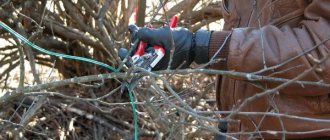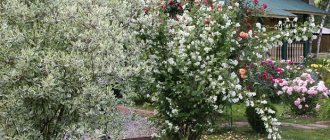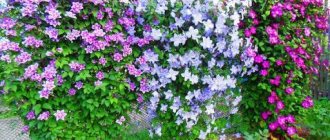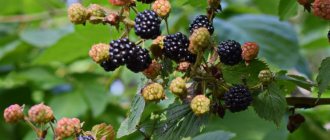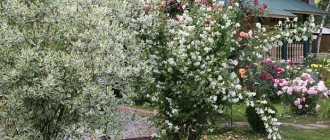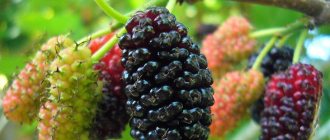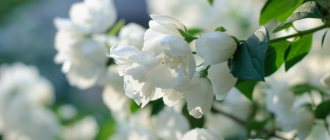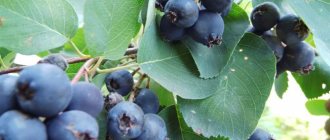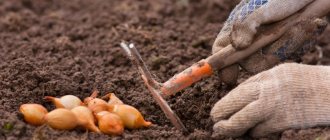4732
Chubushnik (garden jasmine) is an unpretentious frost-resistant plant suitable for cultivation in most regions of Russia. The most popular types are coronal, odorless, large-flowered, and small-leaved. Based on them, breeders developed various varieties: from dwarf varieties (Gnome, Dwarf, Yunnat) to tree-like varieties (Ballet of Moths, Airborne Assault, Snow Avalanche).
Blooming mock orange bush
Many gardeners mistakenly consider this shrub to be a variety of jasmine. However, the latter belongs to the Olive family, while mock orange is a representative of the Hydrangeaceae. For mock orange, planting and care are radically different from similar procedures for jasmine. In order to choose the right place for a shrub, plant it and draw up a schedule for seasonal work, you need to get to know the perennial better.
Which is correct: mock orange or garden jasmine?
Mock orange belongs to the Hydrangeaceae family, and jasmine belongs to the Olive family. At the same time, the shrubs are quite similar to each other, especially in their sweet and strong aroma, which is why confusion arises.
In Russia and the CIS countries, mock orange is often called garden jasmine, but real jasmine is a heat-loving plant (subtropical zone) and freezes out in harsh climates. Some of its species are successfully grown at home or in greenhouses (Indian, sambac, etc.).
Our planting rules and tips for caring for outdoors are intended for mock orange or, popularly, “garden jasmine.”
- These names are used in the article as synonymous words, since these names hide the same plant.
In Russian gardens, the most commonly grown mock orange (ordinary), virgin, hybrid winter-hardy varieties of mock orange Lemoine and selection of Vekhov Nikolai Kuzmich.
Chubushnik "Snow Storm"
A SHORT HISTORICAL EXCURSION
Thinking about mock orange, the question involuntarily arises: “Where did this delicate and beautiful plant get such a dissonant name?” It turns out that the whole point is that chibouks for the most expensive smoking pipes have been made from its soft and fragrant wood for more than a century.
North America is considered the birthplace of mock orange. It was from there that in the 15th century it came to Western Europe. And at the beginning of the 18th century, several bushes were brought to Russia by Italian ambassadors as a gift to the royal family. Here, in the royal garden, it was grown along with the most beautiful roses.
Within a few years, mock orange has become the most fashionable beautifully flowering plant. And there was not a single noble garden where this amazingly charming shrub did not grow with a delightful, subtle aroma that filled the garden during flowering.
The selection of mock orange began seriously only in the middle of the last century. The best European varieties were bred by the famous French scientist Lemoine.
In Russia at the same time, wonderful varieties with large flowers and wonderful aromas were created by the brilliant breeder, Professor N.K. Vekhov at the Lipetsk experimental selection station.
Chubushnik: planting in open ground
For the excellent development and flowering of a plant, the planting location, soil and soil mixture, planting distance and planting depth play an important role.
This is a kind of foundation that provides comfortable conditions for growing mock orange in open ground for the next 25-35 years.
Landing location
The plant is best suited to a quiet place, which should be well lit, especially in the first half of the day, but light partial shade at noon is also allowed. It is best to plant mock orange on the south, southeast and southwest sides.
Garden jasmine can grow in the shade, but in this case the flowering will be much weaker, it will stretch out and take on a less beautiful appearance.
Do not plant shrubs in places where rain or melt water accumulates, or where groundwater lies closer than 150 cm from the surface of the earth.
Soil and acidity
Mock orange loves fertile soil with high air and moisture permeability. Light and medium loamy soils rich in humus are well suited to it. At the same time, garden jasmine can grow in poor soil, but then the development and flowering of the bush will be weaker.
Heavy clay soils are not suitable; in this case, more powerful drainage and a “lighter” soil mixture are required. On sandy loam soils, on the contrary, you can do without drainage, and it is better to replace part of the sand with garden soil.
The optimal soil acidity level for mock orange is pH 6.5-7.5 (close to neutral reaction).
Soil mixture
Substrate options for garden jasmine.
- Leaf soil, humus, turf (garden) soil, peat in equal parts is a universal option.
- Turf (garden) soil, humus (compost) and sand – 3:2:1. Well suited for clay soils and black soil.
- Humus, black soil – 1:1. Preferred option for sandy soils.
- It is advisable to add one glass of wood ash or two tablespoons of superphosphate to any soil substrate.
Landing distance
Large shrubs and trees - 2.5-3 m. When planting mock orange in groups, the distance depends on its type, approximately 80-140 cm. If you want to make a hedge of garden jasmine then - 60-80 cm, the place should be well lit.
Mock orange hedge
Planting depth
When planting, the root collar of the seedling should be located approximately at ground level. The maximum depth is 2-3 cm, otherwise there is a high risk of rot development.
How to plant garden jasmine correctly? Instructions
- Dig a planting hole: depth and width - 50-60 cm. At the bottom of the hole, make a 10-15 cm drainage layer of crushed stone, gravel or sand.
- Add some potting mix. Place the seedling in the center of the hole so that the base of the bush is approximately at ground level.
- Gradually fill the planting hole with soil mixture and compact it so that there are no voids.
- Trim all shoots to about 30% of their length (a couple of buds to a strong bud). Water the seedling in the tree trunk circle with 10-15 liters of water. Place a 3-4 cm layer of peat, bark or sawdust on top to keep the root ball moist longer.
Rules and tips
- Plant mock orange in cloudy weather or in the evening to help it establish better.
- It is advisable to dig the planting hole and fill it with soil mixture 3-4 weeks before planting.
- If the seedling has damaged roots, remove them and treat the cut with charcoal powder.
When is it better to plant mock orange in spring or autumn?
Garden jasmine is best planted in spring (April) or autumn (September - October).
A seedling with an open root system can only be planted in the spring before the leaves bloom, otherwise it will die, and in the fall from September 10 to October 15. Seedlings in containers can be planted throughout the growing season.
These dates for planting mock orange are also suitable for gardeners in the Moscow region, Leningrad region, the Urals and Siberia.
Mock orange seedling in a container for planting in open ground
Reproduction methods
Mock orange is propagated in 4 ways.
Cuttings
This method is considered the most reliable, since the cuttings take root well. Cuttings from developed shoots are cut as planting material. It is better not to use young shoots; they have a hollow core that can rot.
The most effective material for planting is an annual shoot with a part (base) of last year's shoot.
A cut cutting 8–10 cm long is treated with a preparation to form roots and planted in a container with fertile soil to a depth of 1 cm. A glass cap helps create conditions like in a greenhouse. They cover the planting material. A greenhouse is also suitable for these purposes. Cuttings must be sprayed daily to speed up the rooting process, which lasts about two months.
By layering
To propagate garden jasmine using this method, you must select healthy plants. During the growing season, young flexible shoots, before leaves appear on them, are bent to the ground, placing a wire rope above the lower bud at a distance of 1 cm. The stem thickens over time, and roots appear on it. It is carefully sprinkled with fertile soil. A rooted shoot needs regular watering and hilling.
Young shrubs should be planted in the fall. It is better to transplant it temporarily into the garden so that it gets stronger. Replant to a permanent location in a year or two.
Seeds
When growing shrubs from seeds, you need to be patient, since this process takes longer than previous methods. Jasmine will bloom no earlier than five years after planting.
Seeds can be purchased at the store or collected independently after flowering, when “boxes” with ripe seeds form. The seed sowing period is November or March. When planting in the spring, the seeds are placed in a prepared solution for three hours to stimulate their growth. Then this bag of seeds is placed in sawdust for 2-3 days. The next stage is sowing into a container with moist soil, consisting of three components - sand, humus and peat. The seeds are sprinkled with a thin layer of peat on top and moistened.
When 3-4 leaves appear on the seedlings, it is necessary to dive. You can plant the shoots in separate cups and grow them indoors until they reach 30 cm in height. Watering should be moderate, without drying out or stagnating moisture in the soil. A strengthened plant can be transplanted into open ground.
Dividing the bush
Large mock orange shrubs are difficult to propagate using this method. For this it is better to use young plants. The bush is carefully dug up, and excess soil from the root system is carefully removed. When dividing a bush, they look at the development of the roots in order to harm them as little as possible. This propagation method is best used in the fall, in October.
Mock orange transplant
The garden jasmine bush is relatively easy to transplant at any age. The optimal time for transplanting adult bushes is from late August to mid-October, but it is also possible in the spring in April.
- The day before digging, water the mock orange abundantly so that it is easier to move with a lump of earth, and it will stock up on nutrients.
- Trim young shoots of the current year (autumn) or last year's by 30-40% (spring).
- Carefully dig up the bush, plant it together with a lump of earth in a new place and water it with 10-15 liters of water.
Landing dates
Experienced gardeners advise planting garden jasmine in early September. However, actual planting times vary depending on the region in which the shrub will grow. For example, in Siberia, mock orange is planted from September 3-15. Similar growing conditions are used in the Urals. Gardeners in the central and southern regions of our country plant mock orange from mid-September to the end of October.
In particular, garden jasmine is planted in the Moscow region from September 20 to October 15. It is better not to plant this shrub in summer and spring - the gardener will not have time to carry out the work necessary for planting, and the plant may die. If you want to start landscaping your garden with the onset of the first days of spring, you should plant mock orange before the buds begin to bloom.
In autumn, the plant is dormant, but this does not prevent it from adapting to harsh climatic conditions. And the gardener does not have to worry that he will not have time to take care of the plant.
Chubushnik: care in open ground in spring, summer and autumn
The shrub is quite unpretentious in care, drought-resistant and resistant to adverse external factors.
However, to obtain maximum decorative value from garden jasmine, it is necessary to properly care for it.
Watering
Moisture is of great importance for mock orange. If it is deficient, the bush may not bloom. Water garden jasmine regularly, especially in hot and dry weather, to prevent the leaves of the bush from drooping (loss of turgor).
The maximum moisture requirement is from April to July, when the bush is actively growing, preparing for flowering and blooming. During this time, water approximately every 7-12 days with 15-30 liters of water.
We recommend reading: “ WHAT IS THE BEST WATER TO WATER PLANTS? »
In the spring, before flowering begins, it is advisable to spray the bush with warm and soft water. For young plants, it is useful to add growth stimulants to the water (Zircon, Epin Extra and others).
After the first watering in the spring, mulch the tree trunk circle with a 3-4 cm layer of peat to retain moisture in the soil.
Loosening the soil
During spring and summer it is necessary to loosen the soil 2-4 times to a depth of 4-6 cm. Also remove weeds in a timely manner - they take away macro- and microelements from the mock orange.
Feeding and fertilizers
For the first two years after planting, mock orange does not need to be fed with mineral fertilizers. Garden jasmine needs additional nutrients for abundant and lush flowering.
- In early April (before the leaves bloom), dissolve 15 grams of carbamide (urea), 15 grams of potassium sulfate and 30 grams of superphosphate in 10 liters of water and water the bush. Or water the plant with mullein infusion - 1:10.
- After 3-4 weeks (beginning - mid-May), repeat feeding.
- Immediately after flowering, scatter 20-25 grams of superphosphate (1 tablespoon) and 10-15 grams of potassium sulfate per 1 m2 over the surface of the ground.
2nd option
- Before flowering (late April - early May), scatter two tablespoons of nitrophoska and a glass of wood ash over the surface.
- During flowering and immediately after it, water with the solution: 20-25 grams of superphosphate (1 tablespoon) and 10-15 grams of potassium per 10 liters of water.
Adviсe
Instead of mineral fertilizers, wood ash can be used during and after flowering. To do this, pour a glass of ash with 10 liters of water and leave for two days, and then pour the bush into the tree trunk circle.
Bloom
The maximum attractiveness of garden jasmine appears when the fragrant flowers open. It is for its pleasant, sweet and powerful aroma that most gardeners love it.
The smell of mock orange has a beneficial effect on the human psyche and improves mood. The plant usually blooms in the 3rd year after planting.
Mock orange flowering time
The flowering period of garden jasmine depends on its type and variety. In the conditions of the Moscow region, the first to bloom is the crown mock orange and garden forms based on it: golden (aureus), dwarf and variegated. They bloom almost immediately after the common lilac (beginning of June).
In the first two weeks of June, small-leaved mock orange, thin-leaved, and Schrenk's mock orange bloom. In early - mid-July, the odorless, grayish, broad-leaved and fluffy mock orange begins to bloom (it blooms later than all others).
The average flowering time is 20-25 days, a little longer in a shady place. Schrenk's mock orange blooms the longest, and, for example, Gordon's mock orange is able to bloom a second time in the fall.
Chubushnik "Zoya Kosmodemyanskaya"
Why doesn't mock orange bloom? What to do?
Garden jasmine may not bloom in some situations. The most common reasons: lack of lighting (grows in the shade), lack of moisture or nutrients (watering, fertilizing), unsuccessful wintering (freezing of annual shoots), excessive pruning in the spring or too deep planting.
Perhaps the mock orange does not bloom due to its age, especially if you grew it from seeds (7-8 years) or from cuttings (4-5 years).
Development problems and pests of mock orange
Among the many advantages of mock orange is its resistance to diseases and those few pests that are nevertheless tempted by it. Inexperienced gardeners often misdiagnose problems caused by lack of care, mistakenly considering them to be a manifestation of a particular disease.
Care problems
Most of the reasons why mock orange does not bloom lie precisely in the area of care. There are several of them:
- the plant fattens because it is overfed with nitrogen;
- the bush does not have enough light, and we are not talking about light partial shade, but a truly shaded place;
- the bush was pruned too much in the spring, and it threw its energy into restoration;
- pruned late in the summer - the young shoots did not have time to set flower buds (blooms weakly).
Moisture deficiency is the main reason why mock orange leaves curl. During the dry period, the shrub requires abundant watering - 30-40 liters per bush every 2-3 days, and even more often during flowering - it is necessary that the soil does not dry out. Dry autumn is a reason to do moisture-charging watering for the winter.
Mock orange diseases
Fungal diseases affect mock oranges extremely rarely, and their best treatment is to eliminate the causes, as can be seen in the photo below - thickening and waterlogging. Regular pruning promotes free air exchange in the crown area, protecting the foliage from rust and spotting. To destroy pathogenic microflora, spraying with fungicides is recommended.
Proper pruning of mock orange: in spring, after flowering, in autumn
Garden jasmine needs annual pruning to form a decorative crown shape, especially vigorous species and varieties. Otherwise, it will become thickened with young shoots and grow unsightly.
Sanitary pruning in spring
Before the buds awaken (late March - early April), remove weak and damaged shoots growing inside the bush. If desired, you can trim back some of the strongest branches, but be careful as over-pruning may result in no flowering this year.
Sanitary pruning can be carried out at any time of the year. You will complete the full formation of the crown of the bush after the mock orange has flowered.
Anti-aging pruning
Approximately once every 2-4 years it is necessary to rejuvenate the plant. Early in the garden jasmine, cut off all shoots older than 10-12 years at the very base of the bush (“to the stump”).
Due to such pruning, the crown of garden jasmine will be rejuvenated and powerful flowering and growth will be stimulated. New strong shoots will bloom next summer.
"Updating" an old bush
It is easier to rejuvenate a very old or neglected bush by radical pruning.
- At the end of April, cut down all the trunks at ground level, and cut the 3-4 healthiest ones at a height of 35-40 cm. Treat the cut areas with garden varnish, and spread a 4-5 cm layer of humus around the bush and dig up the soil a little (6-8 cm) .
- In the summer, water the mock orange regularly and abundantly. It is also advisable to feed with mullein infusion 1-2 times.
- In the fall, new shoots will appear from dormant buds, but in the spring, 3-4 of the strongest ones will need to be left and the rest completely removed. These most developed shoots are the basis of the young bush.
Formative pruning of mock orange after flowering
Formative pruning of garden jasmine is best done immediately after flowering (mid-June) so as not to disturb flowering, since it blooms on last year's shoots.
- First, remove all faded inflorescences. If you did not prune in the spring or there is a need, then remove all weak and damaged branches entirely.
- Then trim the current year's shoots back to last year's growth (the green part of the branch to the woody part). By October, new growth will have appeared on these branches with side shoots on which flowers will appear next spring. If you want to reduce the height of the bush, then trim all or the longest shoots below the growth zone.
- Also prune 4-5 year old shoots growing inside the bush and bare, weakly flowering shoots to thin it out. And if the bush has become very thick, then cut off 20-25% of the old trunks at the base.
Pruning mock orange in autumn
You cannot prune young shoots of garden jasmine in the fall if you want it to bloom next year. In the fall, if necessary, you can carry out sanitary pruning and thinning of the bush (inward growing and weak shoots).
Preparing mock orange for winter
Most plant varieties are distinguished by good winter hardiness, especially domestic selection. Adult mock orange bushes do not need winter shelter, and specimens up to 2 years old should be mulched with a 4-5 cm layer of peat or pine needles.
If the tops of annual shoots of an adult garden jasmine freeze in winter, it will still bloom, and with the help of pruning in the spring it is easy to restore the crown of the bush.
In the conditions of the Moscow region, Leningrad region, Siberia and the Urals, it is better to plant winter-hardy varieties.
Types and varieties
Despite the fact that this plant has no more than 10 species, there are a huge number of varieties and hybrids of jasmine. They differ in the height of the bush, the size and appearance of the flowers, the time and duration of flowering, as well as their frost resistance.
It is not worth purchasing heat-loving varieties of jasmine for cultivation in the Moscow region - there is a high probability of the plant freezing even if there is a winter shelter.
The most common type of jasmine in the middle zone is the crown mock orange. The height of the bush reaches 3 m; the flowers are simple white with a cream tint and open in early June. If you prefer this type of jasmine, you should pay attention to the Snowbel variety. It differs significantly from other representatives of the crown mock orange in the compactness of its crown (the height of the bush is no more than 1 m) and large double flowers. Snowbell jasmine blooms profusely from June to July.
The Lemoine mock orange has proven itself quite well in the Moscow region. This hybrid species has a slightly lower winter hardiness index than the previous representative, so to prevent the plants from freezing for the winter, it is recommended to cover them, especially in the first years after planting.
The most common varieties of Lemoine jasmine are mock orange Manto de Hermine and Schneeshturm. Despite the family ties, these varieties differ significantly from each other. Manto de Hermine is a low shrub with white, semi-double, rather long-lasting inflorescences. Schneeshturm is valued for its large double flowers, which, under their weight, bend the jasmine branches to the ground. The height of this shrub reaches a height of more than 2 m, and its flowering lasts only 2-3 weeks.
